

Tabella consociazione. Tabella consociazione. Ecco alcuni esempi di consociazione in agricoltura ovvero come alcune piante possano trarre beneficio dalla vicinanza con altre o come sia meglio in alcuni casi tenere lontane le colture: ► Aglio Contribuisce alla crescita e alla salute di rose e lamponi. ► Basilico migliora gusto e sviluppo dei pomodori.
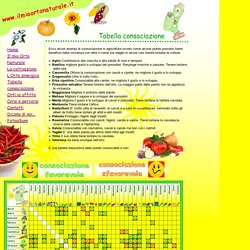
Respinge mosche e zanzare. Tenere lontano dalla ruta. ► Camomilla Ottima la consociazione con cavoli e cipolle: ne migliora il gusto e lo sviluppo. ► Dragoncello Utile in tutto l'orto. ► Erba cipollina Consociabile alle carote: ne migliora il gusto e lo sviluppo. ► Finocchio selvatico Tenere lontano dall'orto. . ► Maggiorana Migliora il profumo delle piante. ► Melissa Migliora il sapore e lo sviluppo dei pomodori. ► Menta Migliora il gusto e lo sviluppo di cavoli e pomodori.
. ► Mentuccia Tiene lontana l'altica. ► Nasturtium E' molto utile ai ravanelli, ai cavoli e a tutte le cucurbitacee. seminato sotto gli alberi da frutto tiene lontani gli afidi e altri insetti. 7 rules for good intercropping - Grow The Planet. Sustainable Crop Production. Sustainable crop production is a way of growing or raising food in an ecologically and ethically responsible manner.
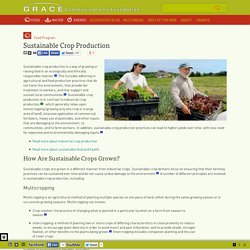
This includes adhering to agricultural and food production practices that do not harm the environment, that provide fair treatment to workers, and that support and sustain local communities. Sustainable crop production is in contrast to industrial crop production, G which generally relies upon monocropping (growing only one crop in a large area of land), intensive application of commercial fertilizers, heavy use of pesticides, and other inputs that are damaging to the environment, to communities, and to farm workers. In addition, sustainable crop production practices can lead to higher yields over time, with less need for expensive and environmentally damaging inputs.
How Are Sustainable Crops Grown? Sustainable crops are grown in a different manner from industrial crops. Multicropping Increased yields. Minimal to No Pesticide Use Focus on Soil Health Organic Fertilizer Use. Intensive Garden with Intercropping. No matter how large your vegetable garden is, there just never seems to be enough space for all you want to plant.
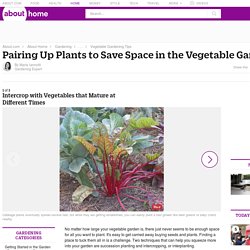
It's easy to get carried away buying seeds and plants. Garden Intercropping: Tips On Interplanting And Intensive Gardening. By Bonnie L.
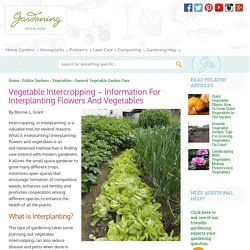
Grant Intercropping, or interplanting, is a valuable tool for several reasons. What is interplanting? Interplanting flowers and vegetables is an old-fashioned method that is finding new interest with modern gardeners. It allows the small space gardener to grow many different crops, minimizes open spaces that encourage formation of competitive weeds, enhances soil fertility and promotes cooperation among different species to enhance the health of all the plants. Intercropping and Polyculture or Relay Cropping in the vegetable Garden. Intercropping is in!
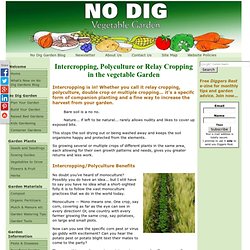
Whether you call it relay cropping, polyculture, double crop or multiple cropping... it’s a specifc form of companion planting and a fine way to increase the harvest from your garden. Bare soil is a no no. Nature... if left to be natural... rarely allows nudity and likes to cover up exposed bits. This stops the soil drying out or being washed away and keeps the soil organisms happy and protected from the elements. Intercropping in a synergistic vegetable garden: an example. Intercropping means creating a combination of different plants that, thanks to particular characteristics, sometimes unknown (because cultivation is always the result of the complex interaction between various factors), gives rise to advantages for one or both of the species.
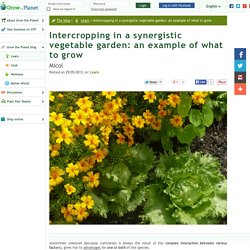
We can also talk of intercropping in the case of two or more plants that, living together, don’t hinder each other in any way and grow normally. In this case the aim of the combination is that of making a piece of land more productive. Organizing a vegetable garden bearing in mind the characteristics of the plants isn’t that easy: you need to follow certain general rules, evaluate what you want to grow and plan what to grow accordingly. Avant-Gardening: Creative Organic Gardening - companion and intensive planting. A garden planted with single rows uses more soil area and resources, is more difficult to mulch, the soil dries out faster and produces more weeds, and becomes quickly compacted from walking and jumping between rows.
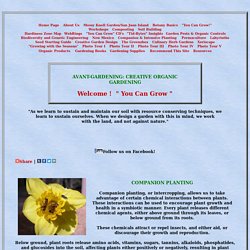
Planting crops closely together in wide rows, takes advantage of the physical and chemical characteristics of each plant. Planting crops close together for the highest yield of each plant will benefit each plant, if planted in symbiotic relationship. Simple, Green, Frugal Co-op: Planning for Intercropping and Succession Planting. By Marc @ GardenDesk Winter is slowly giving up its grip here, which means the vegetable garden is right around the corner.
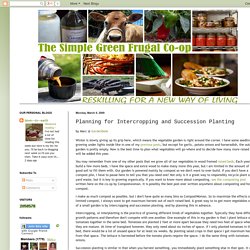
I have some seedlings growing under lights inside like in one of my previous posts, but except for garlic, potato onions and horseradish, the outdoor garden is pretty empty. Now is the best time to plan what vegetables will go where and to decide how many more raised beds will be added this year. You may remember from one of my other posts that we grow all of our vegetables in wood framed raised beds. Each year, we build a few more beds. I make as much compost as possible, but I don't have quite as many bins as CompostWoman. 7 rules for good intercropping - Grow The Planet.
Intercropping. When crops are carefully selected, other agronomic benefits are also achieved.
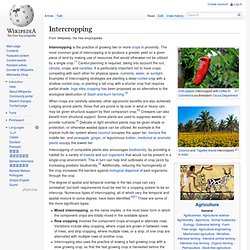
Lodging-prone plants, those that are prone to tip over in wind or heavy rain, may be given structural support by their companion crop.[3] Creepers can also benefit from structural support. Some plants are used to suppress weeds or provide nutrients.[4] Delicate or light sensitive plants may be given shade or protection, or otherwise wasted space can be utilized. An example is the tropical multi-tier system where coconut occupies the upper tier, banana the middle tier, and pineapple, ginger, or leguminous fodder, medicinal or aromatic plants occupy the lowest tier. The degree of spatial and temporal overlap in the two crops can vary somewhat, but both requirements must be met for a cropping system to be an intercrop.
Numerous types of intercropping, all of which vary the temporal and spatial mixture to some degree, have been identified.[6][7] These are some of the more significant types: See also[edit]